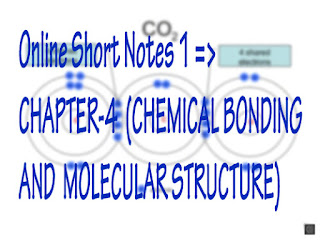These are Online Short Notes 1 =>CHAPTER-4 (CHEMICAL BONDING AND MOLECULAR STRUCTURE) for 11th Class. Go through it to increase your knowledge of chemistry and revise it as much for examinations like CBSE Board, CBSE NEET, CSIR NET, GRE etc.
OCTET RULE : > During a chemical reaction the atoms tend to adjust their electronic arrangement in such a way that they achieve 8 e- in their outermost electron. This is called octet rule.
CHEMICAL BOND : > the chemical force which keeps the atoms in any molecule together is called a chemical bond.
IONIC BOND : > The columbic force of attraction which holds the appositively charged ions together is called an ionic bond.
> An ionic bond is formed by the complete transfer of one or more electrons from the atom of a metal to an atom of non- metal.
LATTICE ENTHALPY : > The molar enthalpy change accompanying the complete separation of the constituent particles that compose of the solids (such as ions for ionic solid, molecules for molecular solids) under standard conditions is called lattice enthalpy (ΔlHo).
> The lattice enthalpy is a positive quantity.
ELECTRO-VALENCY : > The number of electrons lost or gain by an atom of an element is called as electrovalency.
> The element which give up electrons to form positive ions are said to have positive valency, while the elements which accept electrons to form negative ions are said to have negative valency.
FORMATION OF AN IONIC BOND : It is favoured by,
(i) the low ionisation enthalpy of a metallic element which forms the cations,
(ii) High electron gain enthalpy of non- metallic element which forms the anions, (iii) Large lattice enthalpy i.e; the smaller size and the higher charge of the atoms.
COVALENCY : > The number of electrons which an atom contributes towards mutual sharing during the formation of a chemical bond called its covalency in that compound.
SINGLE COVALENT BOND : > A covalent bond formed by the mutual sharing of one pair of electrons is called a single covalent bond, or simply a single bond.
> A single covalent bond is represented by a small line (−) between the two atoms.
DOUBLE COVALENT BOND : > A covalent bond formed by the mutual sharing of two pair of electrons is called a double covalent bond, or simply a double bond.
> A double covalent bond is represented by two small horizontal lines (=) between the two atoms. E.g. O=O, O=C=O etc.
TRIPLE COVALENT BOND : > A covalent bond formed by the mutual sharing of three pair of electrons is called a triple covalent bond, or simply a triple bond.
> A triple covalent bond is represented by three small horizontal lines (≡) between the two atoms. E.g. N≡N, H-C≡C-H etc.
FORMATION OF A COVALENT BOND : > Formation of a covalent bond is favoured by
> High ionisation enthalpy of the combining elements.
> Nearly equal electron gain enthalpy and equal electro-negativities of combining elements.
> High nuclear charge and small atomic size of the combining elements.
POLAR COVALENT BOND : > The bond between two unlike atoms which differ in their affinities for electrons is said to be polar covalent bond. E.g. H-Cl
COORDINATE BOND : > The bond formed when one sided sharing of electrons take place is called a coordinate bond. Such a bond is also known as dative bond.
> It is represented by an arrow (→) pointing towards the acceptor atom. E.g. H3N→BF3
Bond Length : > Bond length is defined as the equilibrium distance between the nuclei of two bonded atoms in a molecule.
Bond Angle :
Bond Enthalpy : > It is defined as the amount of energy required to break one mole of bonds of a particular type between two atoms in a gaseous state.
Bond Order : > In the Lewis description of covalent bond, the Bond Order is given by the number of bonds between the two atoms in a molecule
Resonance : > whenever a single Lewis structure cannot describe a molecule accurately, a number of structures with similar energy, positions of nuclei, bonding and non-bonding pairs of electrons are taken as the canonical structures of the hybrid which describes the molecule accurately.
Dipole moment : > The product of the magnitude of the charge and the distance between the centres of positive and negative charge.
> It is a vector quantity and is represented by an arrow with its tail at the positive centre and head pointing towards a negative centre.
> Dipole moment (μ) = charge (Q) × distance of separation (r)
SIGMA BOND : > A covalent bond formed due to the overlapping of orbitals of the two atoms along the line joining the two nuclei (orbital axis) is called sigma (σ) bond.
> For example, the bond formed due to s-s and s-p, p-p overlapping along the orbital axis are sigma bonds.
Pi- BOND : > A covalent bond formed by the side wise overlapping of p- or d-orbitals of two atoms is called as pi (π) bond.
> For example, the bond formed due to the sideways overlapping of the two p- orbitals is a pi- bond.
HYDROGEN BOND : > The bond between the hydrogen atom of one molecule and a more electro- negative element of same or another molecule is called as hydrogen bond.
HYBRIDIZATION : > The process of mixing of the atomic orbitals to form new hybrid orbitals is called hybridization.
> All hybrid orbitals of a particular kind have equal energy, identical shapes and are symmetrically oriented in shape.
> The hybrid orbitals are designed according to the type and the atomic orbitals merging together, e.g.




No comments:
Write comments